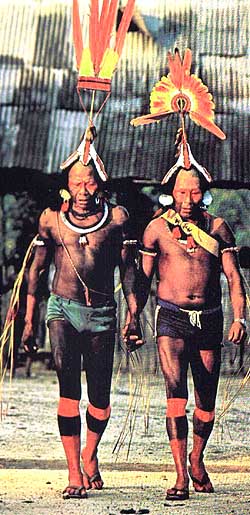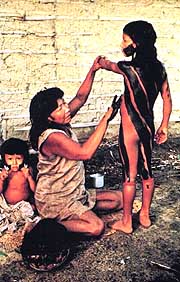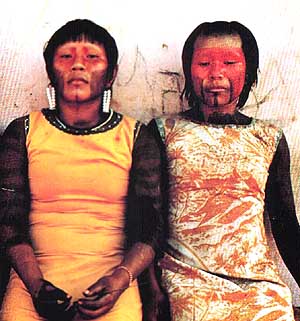by Chalerm Raksanti
Smack in the middle of north central Brazil lays the
preserve of the forest dwelling tribe of Kayapo Indians. As a Stone Age
society, they are facing the dilemma of the temptations of the white
mansí riches and their own traditional way of life.
 The
ceremonial headdress is worn by village chiefs during the dry season
festival.
The
ceremonial headdress is worn by village chiefs during the dry season
festival.
At the turn of the 20th century, the Brazilian
government relocated the Kayapos to Gorotire. At one time there were
several thousand Kaypao established in one community; however, internal
strife and diseases introduced from the outside decimated their numbers.
Today, about 4,000 Kayapo live in 13 villages, Gorotire being the largest
with about 800 residents. It lies in a parcel of land the size of the
American state of Maryland, and the reserve is protected by the
governmentís department for Indian protection, FUNAI.
Like so many tribes, the Kayapo are trying to fathom
the mystery of the bedazzling wealth of the white manís world, the
source of wondrous products like coca cola, cookies, firearms and tape
recorders.
 Mothers
spend hours every day body painting their children with geometric
patterns.
Mothers
spend hours every day body painting their children with geometric
patterns.
Nonetheless, in the world of the Kayapo, tradition and
ritual is the stuff of life. Village leaders rattle gourd instruments and
chanting men in body paint perform circle dances during their annual
festivals. They have a rich repertoire of song and it is stirring to hear
a large chorus of voices ringing out under the vast star spangled sky of
the forest night.
The traditional symbol of Kayapo manhood was a pens
sheath and a light wooden disk inserted into the bottom lip. But the
sheath was uncomfortable and the lip disk made it impossible to speak
Portuguese. They now wear shorts. A village chief treasures his headdress
of matched parrot feathers and the lengths of beads he and his family
wear. These headdresses and kilos of beads establish the wealth of each
household and are considered family heirlooms. The dry season festival is
called Bemp, after a local fish. This is the time for initiation rites,
marriages and the presentation of ancestral names to little boys.
 The
fairest in the village, these young ladies are prime marriage material
The
fairest in the village, these young ladies are prime marriage material
Elaborate headdresses are worn by village leaders. They
are made from beeswax and from the center is woven a radiating sun of
feathers. These headdress patterns represent the universe. The shaft
symbolizes the cotton rope from which it is believed the first Kayapo
descended from the sky.
Despite the encroachment of the outside world, Gorotire
maintains much of its highly developed ceremonial life. Body painting,
equally cosmetic and symbolic, is part of traditional attire. Adults paint
each other in group sessions and women spend hours decorating their
children. With palm brushes and using various fruit dyes, they paint
striking geometric designs of body and face, and often animal markings,
mostly bees and wasps. Kayapo women bedeck their children lavishly with
beads.
The future of Brazilís Indians hinges on the
continuing struggle for their rights and their stand against developers.
The Kayapo feel the outside pressures, and are striving to keep alive a
way of life which is not only fragile, but in many places, being replaced
by white intruders.

 The
ceremonial headdress is worn by village chiefs during the dry season
festival.
The
ceremonial headdress is worn by village chiefs during the dry season
festival. Mothers
spend hours every day body painting their children with geometric
patterns.
Mothers
spend hours every day body painting their children with geometric
patterns. The
fairest in the village, these young ladies are prime marriage material
The
fairest in the village, these young ladies are prime marriage material